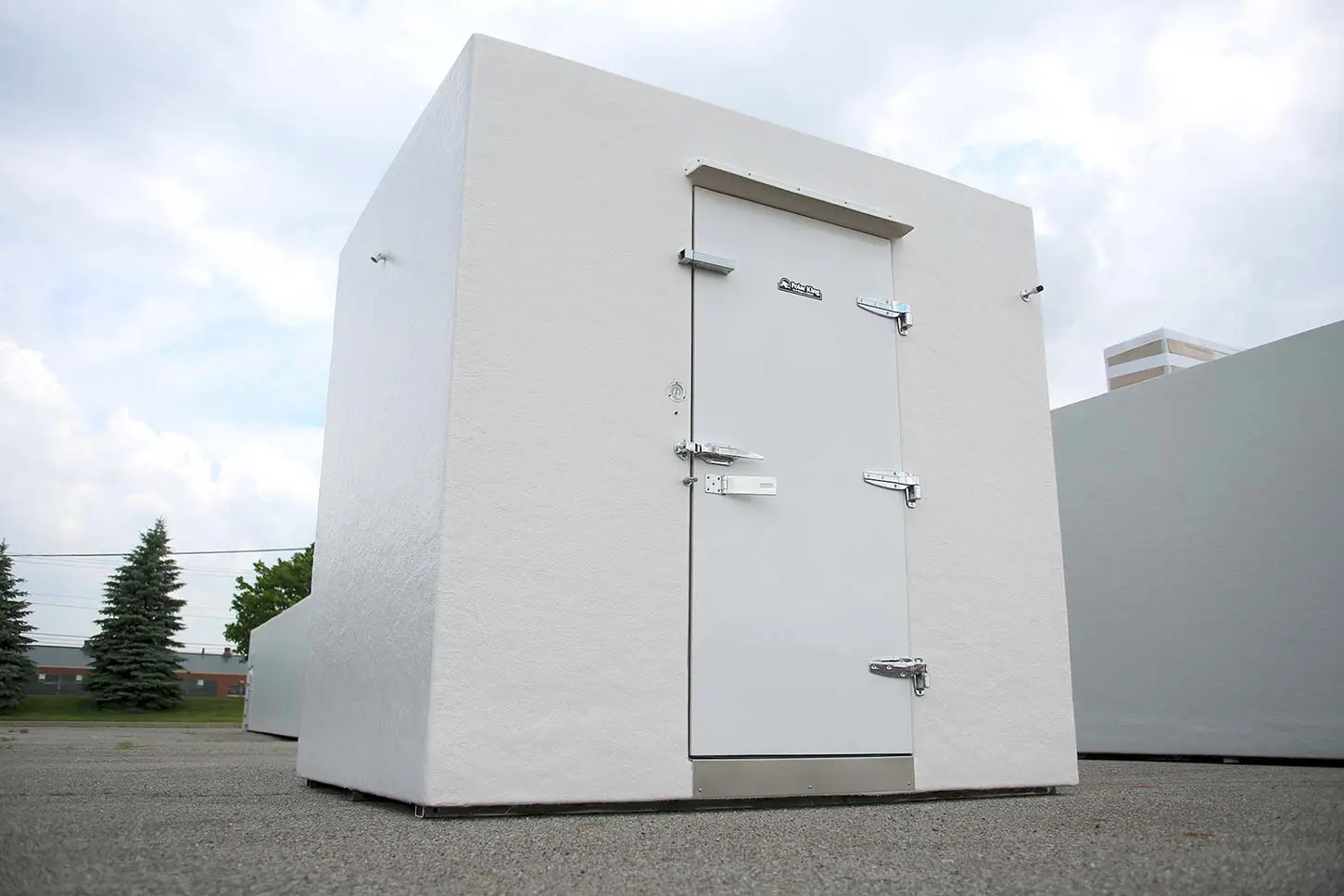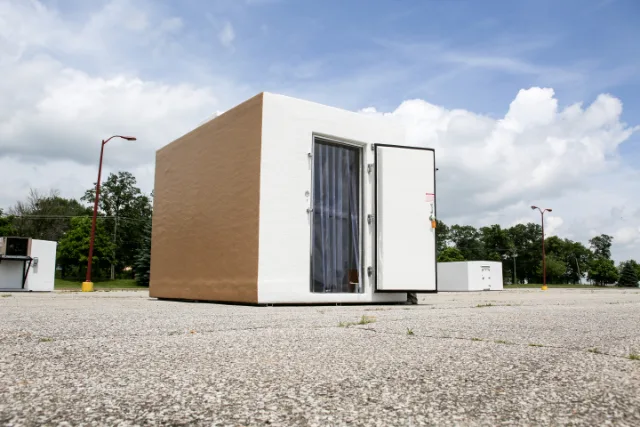
You need a cold storage solution but don’t quite understand the difference between outdoor refrigeration vs. indoor walk in coolers besides the obvious — one is located outdoors and the other indoors. Though each unit has its advantages, choosing one over the other comes down to taking specific factors into account, like business needs and environmental considerations.
We’re here to help. Though Polar King specializes exclusively in fiberglass outdoor walk in coolers and freezers, we want to equip customers with the proper knowledge to ensure they make the right decision moving forward.
So, what is the difference? Let’s break it down.
1. Size is a factor
As you’d guess, indoor walk in refrigeration code requirements are restricted to where they can be placed inside a building or structure. This means they are typically smaller in size and capacity, which translates to not being able to hold as much product. There’s also the potential for higher installation costs due to ventilation or structural modifications.
In contrast, a walk in freezer designed for outdoor use can provide more storage space and capacity for customers with limited internal capacity. No need to sacrifice valuable interior square footage. Polar King walk in freezers are customizable to fit a wide range of size requirements, offering flexibility for businesses of all scales. Plus, these outdoor units are pre-assembled and delivered ready for use, eliminating installation challenges. Additionally, our outdoor walk in coolers are available in both compact models for limited outdoor space and larger sizes to handle high-volume storage.
On a similar note, companies should bear in mind that indoor walk in units typically must be panel-built on site. Click here for a full comparison of pre-built and “assembled on site” walk in refrigeration units.
Outdoor vs. indoor walk-in takeaways re: size:
Indoor walk-ins: Limited by building codes and available interior space, indoor units are usually smaller and may incur extra installation costs for ventilation or structural changes.
Outdoor walk-ins: Freed from interior square-footage constraints, outdoor units can be sized up or down to suit demand, arrive pre-assembled, and expand storage capacity without major on-site work.
2. Location, location, location
Indoor walk in coolers are usually found in a building’s backroom, kitchen or storage area, making it easy for employees to access but harder for deliveries and stock management due to limited outdoor access. In contrast, outdoor walk in freezers serve as effective extensions of operations without requiring major remodeling. No tearing down walls necessary.
With that said, the placement of the outdoor walk in cooler is important considering its proximity to kitchens, delivery areas and overall site coordination. Since no two businesses are the same, selecting the right type and location of a walk-in cooler requires a tailored approach. By consulting with a workflow specialist, you can identify the most efficient solution tailored to your specific needs.
Geographic location is equally as important.

Whereas temperature and weather aren’t typically a factor for the installation of indoor walk in coolers, mother nature can be an issue for the usage of outdoor refrigeration. Fortunately, Polar King’s fiberglass construction ensures all-weather resilience meaning they can withstand the harshest weather environments, from a hurricane to a blizzard, and everything in between.
Whether your business is located within the scorching heat of Arizona summers or the bitter cold of Minnesota winters, our durable construction and advanced insulation ensure consistent temperature control, providing businesses with a dependable solution for year-round use.
Outdoor vs. indoor walk-in takeaways re: location:
Indoor walk-ins: Installed inside backrooms or kitchens, they are convenient for staff but restrict delivery access and inventory flow, with virtually no weather-related constraints.
Outdoor walk-ins: Placed externally to expand capacity without interior remodeling, they simplify deliveries yet require strategic site placement and durable, weather-proof construction adapted to local climate conditions.
3. Energy efficiency
Next, let’s look at the difference between outdoor refrigeration vs. indoor for energy efficiency. Typically, outdoor walk in coolers require more energy to maintain temperature consistency. Naturally, because they are located inside a building, indoor walk in freezers are not as affected by outside temperatures. Less energy usage means lower energy costs.
Most outdoor walk in units on the market are similar and are constructed of insulated foam panels sandwiched between two pieces of metal. When selecting an outdoor walk in freezer, consider the materials and design for long-term performance. Polar King’s patented fiberglass construction excels in high-temperature differentials (TD), offering superior resistance to heat and moisture. Because these units absorb little heat, Polar King’s walk in cooler designed for outdoor use is among the most energy-efficient solutions on the market.
Outdoor vs. indoor walk-in takeaways re: energy efficiency:
Indoor walk-ins: Located within a climate-controlled building, indoor units face minimal external temperature swings, so they use less energy and deliver lower operating costs.
Outdoor walk-ins: Outdoor units typically consume more energy to offset weather extremes, but advanced fiberglass-insulated designs like Polar King’s curb heat gain and stand out as highly efficient options.
4. Maintenance and repairs
Maintenance is yet another area where outdoor refrigeration vs. indoor differs in important ways. Indoor walk-in freezers, while shielded from harsh weather conditions, still face significant wear and tear due to the high volume of daily usage. Frequent employee access increases the chances of doors being left open too long, which can strain the refrigeration system and allow moisture to accumulate—potentially leading to ice buildup, mold growth, or spoiled inventory.
Forklift traffic and heavy equipment use can also damage gaskets, door hinges, and interior panels over time. Without regular inspections, these small issues can snowball into costly repairs or reduced cooling efficiency. Routine cleaning, checking of drain lines, calibrating thermostats, and ensuring proper door seals are essential tasks to maintain performance and extend the unit’s lifespan.
Outdoor walk-in coolers and freezers, on the other hand, introduce an entirely different set of maintenance challenges. Because they’re exposed to the elements, weatherproofing becomes a critical concern. Seasonal temperature changes can affect insulation performance, while snow, rain, and UV exposure may compromise the unit’s roof, exterior paneling, or door frames if not properly maintained.
Pests are also a higher risk outdoors, so regular inspection of seals and vents is crucial. Additionally, outdoor units may require more frequent checks of electrical components and refrigeration lines, which are vulnerable to environmental damage. Preventative maintenance—such as ensuring proper drainage, cleaning condenser coils, and inspecting structural integrity—is key to keeping outdoor units running efficiently throughout the year.
Outdoor vs. indoor walk-in takeaways re: maintenance & repairs:
Indoor walk-ins: Frequent employee traffic and door misuse accelerate wear on seals, hinges, and interior surfaces, making diligent inspections and routine cleaning essential to prevent efficiency loss and costly repairs.
Outdoor walk-ins: Constant exposure to weather and pests requires rigorous weatherproofing, drainage, and component checks (especially for insulation, roofing, and refrigeration lines) to sustain reliable performance year-round.
Pros and cons: indoor vs. outdoor walk in coolers
To simplify your decision-making process, we’ve created a list of pros and cons between the two options.
| Type | Pros | Cons |
|---|---|---|
| Indoor Walk-In Coolers | – Easy employee access – Lower energy costs – Protected from weather | – Limited storage space – Higher installation costs – Challenging deliveries |
| Outdoor Walk-In Coolers | – Larger, customizable storage – Flexible placement – Durable | – Higher energy use – Exposed to weather – Requires careful site planning |
Outdoor walk in freezer benefits: making the final decision
Now that it’s time to choose the right walk in unit for your business, be sure to consider important factors such as space optimization, durability and energy efficiency. Polar King’s outdoor walk in coolers are designed to withstand harsh weather, save energy and offer flexible placement options without compromising internal space. If you’re unsure which option fits your needs, contact our team for a consultation to discuss how our solutions can meet your specific requirements.
Indoor vs. Outdoor Coolers FAQs
Can you put an outdoor walk-in cooler inside?
Maintenance for indoor and outdoor walk-in coolers differs mainly due to their exposure and usage. Indoor units are protected from weather but face wear from frequent access, door misuse, and equipment damage, requiring consistent upkeep. Outdoor units are more vulnerable to weather, pests, and insulation issues, making weatherproofing and structural checks essential. Both need regular maintenance to stay efficient, but the challenges and priorities vary by location.
Can you put an indoor walk-in cooler outside?
You should not put an indoor walk-in cooler outside, as it’s not designed to withstand outdoor conditions. Indoor units lack the necessary weatherproofing and insulation to handle temperature fluctuations, rain, snow, and UV exposure. Placing one outside can lead to equipment failure, energy inefficiency, and shortened lifespan. If outdoor installation is needed, it’s important to use a unit specifically built and rated for exterior use.
What makes a walk-in freezer designed for outdoor use different?
A walk-in freezer designed for outdoor use includes features that protect it from weather and environmental damage. These units have enhanced insulation, weatherproof exterior panels, and reinforced roofing to withstand rain, snow, and temperature extremes. They also often include heated door frames and weather-resistant electrical components to prevent freezing and condensation issues. These design elements ensure the freezer remains efficient and reliable year-round, even in harsh outdoor conditions.
What are the core outdoor walk-in cooler benefits?
Outdoor walk-in coolers offer several key benefits, especially for businesses with limited indoor space. They provide larger, customizable storage options and can be placed in flexible locations without disrupting workflow inside the building. Their durable construction is built to handle weather and environmental exposure. By freeing up indoor space and expanding cold storage capacity, they offer a practical solution for growing operations.




